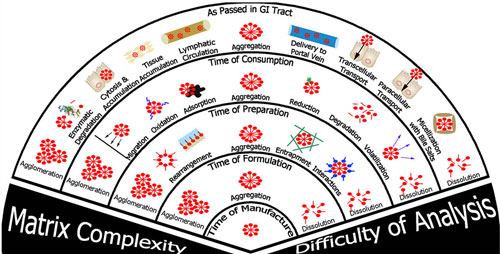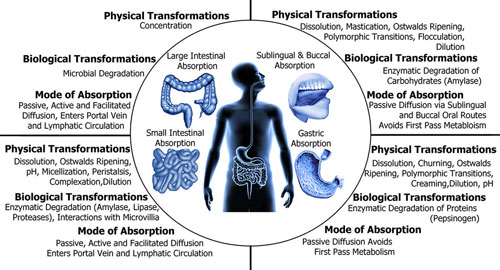| Posted: Aug 22, 2014 | |
How to identify nanomaterials in food |
|
| (Nanowerk Spotlight) Nanotechnology, specifically nanomaterial engineering, has begun to find applications in agriculture and the food industry. Some nanomaterials have unique physicochemical properties that can be exploited for beneficial effects on foods, leading to increased shelf life, enhanced flavor release, and increased absorption of nutrients and other bioactive components. | |
| Of course, there seems to be no limit to what food technologists are prepared to do to our food and nanotechnology will give them a whole new set of tools to go to new extremes. In our special Food Nanotechnology section we have prepared an overview of this area. | |
| The ability to detect and to measure a given nanomaterial at key time points in the food lifecycle is critical for estimating the nanoscale properties of interest that dictate manufacturing consistency and safety, as well as understanding potential beneficial or adverse effects from food intercalation. | |
| In a recent perspectives article in ACS Nano ("Measurement of Nanomaterials in Foods: Integrative Consideration of Challenges and Future Prospects"), scientists describe the state of the science for nanoscale measurement methods development as applied to foods and the alimentary tract and, more importantly, to identify the critical methods' knowledge gaps that must be addressed to inform appropriate risk management and public policy. | |
| This article draws from the combined work of experts participating in the NanoRelease Food Additive (NRFA) project, an international multi-stakeholder effort that aims to address method development needs for nanoscale materials currently used in commerce. | |
| Where is the problem? | |
| According to the authors, there are several factors that complicate the development of methods to detect and to measure nanomaterials in foods and food contact materials. | |
| First, whether naturally present or intentionally added to foods, the potential applications and impacts of nanomaterials within these matrices are diverse. | |
| Secondly, it is extremely important to recognize and to differentiate nanoscale materials that are naturally present in the food supply. For instance, prior to industrial processing, dairy products contain a plethora of associated colloids, biopolymeric nanoparticles, and nanoemulsions. | |
| And finally, a considerable characterization challenge includes the consideration of physicochemical changes as a nanomaterial moves from formulation and preparation through incorporation into foods and ultimately through consumption and absorption. These complexities that affect the biological interactions of the nanomaterial could include the effective nanomaterial size (including agglomeration and aggregation), solubility/dispersibility, chemical form, chemical reactivity, surface chemistry, shape, and porosity. | |
 |
|
| Potential modes of destabilization through the lifecycle of a nanomaterial from the time of manufacture to potential biological interactions in the alimentary tract and the complexity/difficulty of sample quantification and detection. GI, gastrointestinal. (Reprinted with permission by American Chemical Society) (click on image to enlarge) | |
| Whereas relatively pristine nanomaterials at the point of their manufacture are fairly straightforward to characterize, these materials undergo physical and/or chemical changes during food processing, packaging, aging, and during their transit through the alimentary tract. Especially this last area – the inherent complexity of the mammalian alimentary tract – creates additional complications for nanomaterial characterization. | |
| As the authors point out, the pH, ionic strength, composition, and absorptive surfaces of the alimentary tract vary considerably, and the composition of the food matrix changes during digestion. In addition, the microflora with which nanoparticles interact may change dramatically in terms of both species and numbers. | |
| For instance, it has been shown that silver nanoparticles exposed to stomach fluid undergo changes in size, shape, and composition, and the rates of these changes are dependent on particle size (see: "Changes in silver nanoparticles exposed to human synthetic stomach fluid: Effects of particle size and surface chemistry"). | |
| But this means that, if size, including the influence of agglomeration/aggregation, can change with environmental conditions, then real-time monitoring of engineered nanomaterial behavior within biological environments will be extremely difficult. Also, numerous preanalysis steps, including degradation of the food matrix and separation of the compounds of interest from background nanomaterials, are required to isolate the nanomaterial for characterization. | |
 |
|
| Endogenous modifications to nanomaterials within the alimentary tract during transport from time of consumption to excretion. (Reprinted with permission by American Chemical Society) (click on image to enlarge) | |
| What approaches are currently available? | |
| "Due to the complexity and wide chemical and physical disparity of nanomaterials at different points in time from processing to ingestion, it is likely that no single method will suffice to characterize the potential benefits or risks that these materials may present to the consumer," write the authors. "A combination of methods aimed at assessing specific questions will likely be needed to ascertain the best analytical results." | |
| They explain that detection methods differ based on the specific questions being addressed, such as the following: | |
|
|
|
| The article then goes on and details the various detection techniques currently available for various nanomaterials. | |
| Concluding, the author team emphasizes the need for interdisciplinary collaboration in order to allow active sharing of knowledge among chemists, physicists, toxicologists, food technologists, instrument vendors, and other important stakeholders: "Moving beyond the isolation of critical information within individual knowledge domains and stakeholder groups will leverage nanotechnology and the nanoscale from an area of perceived uncertainty and debate into a rich field of potential." | |
 By
Michael
Berger
– Michael is author of three books by the Royal Society of Chemistry:
Nano-Society: Pushing the Boundaries of Technology,
Nanotechnology: The Future is Tiny, and
Nanoengineering: The Skills and Tools Making Technology Invisible
Copyright ©
Nanowerk LLC
By
Michael
Berger
– Michael is author of three books by the Royal Society of Chemistry:
Nano-Society: Pushing the Boundaries of Technology,
Nanotechnology: The Future is Tiny, and
Nanoengineering: The Skills and Tools Making Technology Invisible
Copyright ©
Nanowerk LLC
|
|
|
Become a Spotlight guest author! Join our large and growing group of guest contributors. Have you just published a scientific paper or have other exciting developments to share with the nanotechnology community? Here is how to publish on nanowerk.com. |
|
